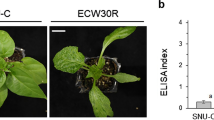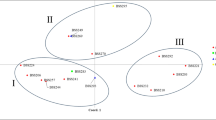Abstract
Crop genome sequencing projects generate massive amounts of genomic sequence information, and the utilization of this information in applied crop improvement programs has been augmented by the availability of sophisticated bioinformatics tools. Here, we present the possible direct utilization of sequence data from a sorghum genome sequencing project in applied crop breeding programs. Based on sequence homology, we aligned all publicly available simple sequence repeat markers on a sequence-based physical map for sorghum. Linking this physical map with already existing linkage map(s) provides better options for applied molecular breeding programs. When a new set of markers is made available, the new markers can be first aligned on a sequence-based physical map, and those located near the quantitative trait locus (QTL) can be identified from this map, thereby reducing the number of markers to be tested in order to identify polymorphic flanking markers for the QTL for any given donor × recurrent parent combination. Polymorphic markers that are expected (on the basis of their position on the sequence-based physical map) to be closely linked to the target can be used for foreground selection in marker-assisted breeding. This map facilitates the identification of a set of markers representing the entire genome, which would provide better resolution in diversity analyses and further linkage disequilibrium mapping. Filling the gaps in existing linkage maps and fine mapping can be achieved more efficiently by targeting the specific genomic regions of interest. It also opens up new exciting opportunities for comparative mapping and for the development of new genomic resources in related crops, both of which are lagging behind in the current genomic revolution. This paper also presents a number of examples of potential applications of sequence-based physical map for sorghum.


Similar content being viewed by others
References
Altschul SF, Miller WGW, Myers EW, Lipman DJ (1990) Basic local alignment search tool. J Mol Biol 215:403–410
Arun SS (2006) In silico EST data mining for elucidation of repeats biology and functional annotation in sorghum [Sorghum bicolor (L.) Moench.]. MSc thesis. University of Agricultural Sciences, Dharwad
Bhattramakki D, Dong J, Chhabra AK, Hart G (2000) An integrated SSR and RFLP linkage map of Sorghum bicolor (L.) Moench. Genome 43:988–1002
Brown SM, Hopkins MS, Mitchell SE, Senior ML, Wang TY, Duncan RR, Gonzalez-Candelas F, Kresovich S (1996) Multiple methods for the identification of polymorphic simple sequence repeats (SSRs) in sorghum [Sorghum bicolor (L.) Moench]. Theor Appl Genet 93:190–198
Cheng L, Wang F, Shou H, Huang F, Zheng L, He F, Li J, Zhao F-J, Ueno D, Ma JF, Wu P (2007) Mutation in nicotianamine aminotransferase stimulated the Fe(II) acquisition system and led to iron accumulation in rice. Plant Physiol 145:1647–1657
Feltus FA, Singh HP, Lohithaswa HC, Schilze SR, Silva TD, Paterson AH (2006) A comparative genomics strategy for targeted discovery of single-nucleotide polymorphisms and conserved non-coding sequences in orphan crops. Plant Physiol 140:1183–1191
Folkertsma RT, Sajjanar GM, Reddy BVS, Sharma HC, Hash CT (2003) Genetic mapping of QTL associated with sorghum shootfly (Atherigona soccata) resistance in sorghum (Sorghum bicolor). In: 11th Int Plant Animal Genome Conf. San Diego. Available at: http://www.intl-pag.org/11/abstracts/P5d_P462_XI.html
Haussmann BIG, Hess DE, Seetharama N, Welz HG, Geiger HH (2002) Construction of a combined sorghum linkage map from two recombinant inbred population using AFLP, SSR, RFLP, and RAPD markers, and comparison with other sorghum maps. Theor Appl Genet 105:629–637
Haussmann BIG, Hess DE, Omanya GO, Folkertsma RT, Reddy BVS, Kayentao M, Weiz HG, Geiger HH (2004) Genomic regions influencing resistance to the parasitic weed Striga hermonthica in two recombinant inbred populations of sorghum. Theor Appl Genet 109:1005–1016
International Rice Genome Sequencing Project (2005) The map-based sequencing of the rice genome. Nature 436:793–800
Kim J-S, Klein PE, Klein RR, Price HJ, Mullet JE, Stelly DM (2005) Chromosome identification and nomenclature of Sorghum bicolor. Genetics 169:1169–1173
Klein RR, Klein PE, Chhabra AK, Dong J, Pammi S, Childs KL, Mullet JE, Rooney WR, Schertz KF (2001) Molecular mapping of the rf1 gene for pollen fertility restoration in sorghum (Sorghum bicolor L.). Theor Appl Genet 102:1206–1212
Kong L, Dong J, Hart GE (2000) Characteristics linkage-map positions and allelic differentiation of Sorghum bicolor (L.) Moench DNA simple sequence repeats (SSRs). Theor Appl Genet 101:438–448
Kresovich S, Barbazuk B, Bedell JA, Borrell A, Buell AR, Burke J, Clifton S, Cordonnier-Pratt M-M, Cox S, Dahlberg J et al (2005) Towards sequencing the sorghum genome. A U.S. national science foundation-sponsored workshop report. Plant Physiol 138:1898–1902
Mace ES, Rami J-F, Bouchet S, Klein PE, Klein RR, Kilian A, Wenzl P, Xia L, Halloran K, Jordan DR (2009) A consensus genetic map of sorghum that integrates multiple component maps and high-throughput diversity array technology (DArT) markers. BMC Plant Biol 9:13
Magalhaes JV, Liu J, Guimaraes CT, Lana UGP, Alves VMC, Wang Y-H, Schaffert RE, Hoekenga OA, Pineros MA, Shaff JE, Klein PE, Carneiro NP, Coelho CM, Trick HN, Kochian LV (2007) A gene in the multidrug and toxic compound extrusion (MATE) family confers aluminum tolerance in sorghum. Nat Genet 39:1156–1161
Martienssen RA (2004) Crop plant genome sequence: what is it good for? Crop Sci 44:1898–1899
Paterson AH, Bowers JE, Gingle A, Paterson DG, Kresovich SE, Messing J, Hash CT, Rokhsar DS (2006) Sequencing of the sorghum genome. In: 14th Int Plant Animal Genome Conf. San Diego. Available at: http://www.intl-pag.org/pag/14/abstracts/PAG14_W65.html
Paterson AH, Bowers JE, Bruggmann R, Dubchak I, Grimwood J, Gundlach H, Haberer G, Hellsten U, Mitros T, Poliakov A, Schmutz J, Spannagl M, Tang H, Wang X, Wicker T, Bharti AK, Chapman J, Feltus FA, Gowik U, Grigoriev IV, Lyons E, Maher CA, Martis M, Narechania A, Otillar RP, Penning BW, Salamov AA, Wang Y, Zhang L, Carpita NC, Freeling M, Gingle AR, Hash CT, Keller B, Klein P, Kresovich S, McCann MC, Ming R, Peterson DG, Mehboob-ur-Rahman WareD, Westhoff P, Mayer KFX, Messing J, Rokhsar DS (2009) The Sorghum bicolor genome and the diversification of grasses. Nature 457:551–556
Ramu P, Kassahun B, Senthilvel S, Kumar CA, Jayashree B, Folkertsma RT, Reddy LA, Kuruvinashetti MS, Haussmann BIG, Hash CT (2009) Exploiting rice-sorghum synteny for targeted development of EST-SSRs to enrich the sorghum genetic linkage map. Theor Appl Genet 119:1193–1204
Reddy PS, Fakrudin B, Rajkumar PunnuriSM, Arun SS, Kuruvinashetti MS, Das IK, Seetharama N (2008) Molecular mapping of genomic regions harboring QTLs for stalk rot resistance in sorghum. Euphytica 159(1–2):191–198
Schloss SJ, Mitchell SE, White GM, Kukatla R, Bowers JE, Paterson AH, Kresovich S (2002) Characterization of RFLP probe sequences for gene discovery and SSR development in Sorghum bicolor (L.) Moench. Theor Appl Genet 105:912–920
Sivasudha T, Kumar PA (2007) Sequence analysis of cereal sucrose synthase genes and isolation of sorghum sucrose synthase gene fragment. African J Biotech 6(20):2386–2392
Tang H, Bowers JE, Wang X, Ming R, Alam M, Paterson AH (2008) Synteny and collinearity in plant genomes. Science 320:486–488
Tao YZ, Henzell RG, Jordan DR, Butler DG, Kelly AM, McIntyre CL (2000) Identification of genomic regions associated with stay green in sorghum by testing RILs in multiple environments. Theor Appl Genet 100:1225–1232
Taramino G, Tarchini R, Ferrario S, Lee M, Pe′ ME (1997) Characterization and mapping of simple sequence repeats (SSRs) in Sorghum bicolor. Theor Appl Genet 95:66–72
Voorrips RE (2002) MapChart: software for the graphical presentation of linkage maps and QTLs. T J Hered 93:77–78
Westhoff P, Gowik U (2004) Evolution of C4 phosphoenolpyruvate carboyxlase genes and proteins: A case study with the genus Flaveria. Ann Bot 93:13–23
Wu YQ, Huang Y (2006) An SSR genetic map of Sorghum bicolor (L.) Moench and its comparison to published genetic map. Genome 50:84–89
Yonemaru JI, Ando T, Mizzubayashi T, Kasuga S, Matsumoto T, Yano M (2009) Development of genome–wide simple sequence repeat markers using whole-genome shot-gun sequences of sorghum (Sorghum bicolor (L.) Moench). DNA Res 16:187–193
Acknowledgments
The research fellowship provided to PR by the Council of Scientific and Industrial Research (CSIR), New Delhi, India is greatly acknowledged. We also thank to Dr. A.H. Paterson for his action that led to sorghum genome sequencing. We acknowledge the Generation Challenge Program (GCP) for providing the Paracel high-performance computing facility at ICRISAT, Patancheru. We also thank Dr. Fakrudin (University of Agricultural Sciences, Dharward, Karnataka, India) for providing the EST–SSR primer pair sequences in sorghum and Mr. Yogesh for providing the information related to transferability of sorghum EST–SSRs in sugarcane.
Author information
Authors and Affiliations
Corresponding author
Additional information
P. Ramu and S. P. Deshpande have contributed equally to this study.
Electronic supplementary material
Below is the link to the electronic supplementary material.
Supplement Table 1
Details of Xgpsb, Xisep, Xiabtp and XmSbCIR series SSR markers reported in this study (XLS 182 kb)
Supplement Table 2
Details of 7013 sorghum SSR markers, their physical positions and relationship with adjacent SSR markers (XLS 791 kb)
Supplement Table 3
Locations of important genes reported in sorghum and other cereals on sorghum genome (XLS 67 kb)
Supplement Table 4
List of selected markers for diversity analysis spanning entire genome of sorghum (XLS 42 kb)
Supplement Table 5
Marker details for the introgression of ‘QTL G’ responsible for imparting shoot fly resistance in sorghum (XLS 32 kb)
Rights and permissions
About this article
Cite this article
Ramu, P., Deshpande, S.P., Senthilvel, S. et al. In silico mapping of important genes and markers available in the public domain for efficient sorghum breeding. Mol Breeding 26, 409–418 (2010). https://doi.org/10.1007/s11032-009-9365-9
Received:
Accepted:
Published:
Issue Date:
DOI: https://doi.org/10.1007/s11032-009-9365-9




